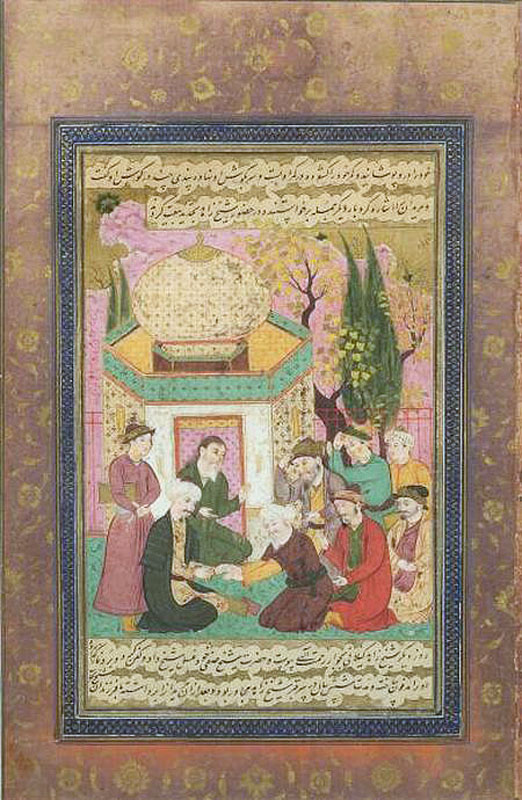Location: Present Whereabouts Unknown.
Mount: Orange mount (now faded) with gold 31.8 x 21.0 cm. Blue collar.
Written surface: not available
Painting: not available
Text references: J.K., p.21 line 14 to p.22 line 5
See Muntaẓer-Ṣāḥeb_1970, p.10 for this event in the History of Shah Esmāʿil.
See Savory, SA_1979, p.23 for this event in the History of Shah ʿĀbbās.
Savory, Safavids_1980, p.8
Date of this event: 700/1301 at Siāhrud, in the province of Gilān.
Shaikh Gilāni, on his deathbed, appointed Shaikh Ṣafi, to whom Esmāʿil traced his lineage, as his heir instead of his own son Jamāl al-Din ʿAli. The story that is related in the text is the following. Shaikh Gilāni had at an earlier point been so impressed with Shaikh Ṣafi that he betrothed his daughter Fāṭema to him in marriage. When Gilāni was near death, he was of the mind to appoint Shaikh Ṣafi as his successor as head mystic, but his followers clamored for him to appoint his own son instead. In order to settle the dispute Shaikh Gilāni proposed a test in which he would call each of them three times (telepathically since they were each beyond hearing range); whoever responded obviously had the greater mystic powers and would be appointed his successor. Shaikh Gilāni called his son three times but Jamāl did not respond. Then he called Shaikh Ṣafi three times, and on the third call Shaikh Ṣafi appeared before him with the following explanation: when you called the first time I was doing my prayers, on the second call I was gathering my things, and when I heard your third call I came immediately -- that is why I have only one shoe on. This story is legend, but the characters actually existed.
Shaikh Gilāni is portrayed as an aold man with a white beard, turban, and brown robe in center foreground. His hands are extended to touch the younger Shaikh Ṣafi who is seated before him. Five followers of the elder Gilāni are seated behind him on the right. They are dressed as darvishes. Behind Ṣafi, on the far left is a standing servent, and just to the right of him before the door of a pavilion is another personage of uncertain identity, bareheaded and wearing a green robe. The scene is set before a tiled hexagonal pavilion with a bulbous dome, with some cypress trees and other shrubbery on either side. In the background is a pink hillside and a gold sky beyond.
Two lines of text above and below the painting. The painting is not signed or dated.
For another version of this event, also painted by Moʿin, see Manuscript M, SE_10
Painting references:
Anderson Gallery, November 30 - December 1, 1923, Lot 292 (not illustrated).
Skinner Auctioneers (Boston) on-line sale catalog, sale 2317, 29 April 2006, Lot 78.
Provenence: Formerly in the Collection of Reżā Khan Monif in New York. It was sold at his estate sale at Anderson Galleries in 1923 for $40. Buyer not known. Reappears again in 2006 at Skinners; names of seller and buyer not known.
Photo after Skinner Auctioneers.
Robert Eng
Last Updated: September 18, 2012 | Originally published: September 18, 2012
